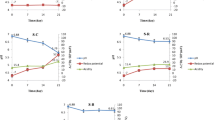Abstract
Dark chocolate masses and chocolates were supplemented with viable cells of two bacterial strains Lactobacillus caseii and Lactobacillus paracasei with potential probiotic properties, which were lyophilized in milk. Total number of live bacteria in the lyophilizate was 7.9×109 cfu/g. Sucrose or isomalt and aspartame were used as bulking substances and sweeteners. Sensory attributes of these chocolates were not different from that of traditional chocolates. Calorie value of sucrose-free chocolate was lower by approximately 11.1–14.6% (dependent on their formulation) relative to chocolate sweetened with sucrose. Chocolate, which contains isomalt and aspartame can be consumed by diabetics. Numbers of live L. casei and L. paracasei cells in the examined batches of chocolate were very high and approached 106–107 cfu/g after 12 months of keeping at 4 and 18 °C. Neither the texture nor the total and volatile acidity of chocolate masses were changed by addition of the lyophilized preparation of Lactobacillus cells. Casson yield values of dark sucrose-free chocolate masses supplemented with this lyophilizate were decreased by approximately 3–55% (dependently on fat contents in these masses) as compared to that of analogous chocolate masses sweetened with sucrose.




Similar content being viewed by others
References
Beckett ST (2000) The science of chocolate. The Royal Society of Chemistry, Cambridge, pp 1–7
Bruinsma K, Douglas LT (1999) J Am Diet Assoc 99:1249–1256
Chevalley J (1994) In Beckett ST (ed) Industrial chocolate manufacture and use. Chapman and Hall, New York, pp 139–154
Edwards B (1997) Chem Br 11:50–52
Irwin WE (1990) Food Technol 44:128
Ndindayino F, Henrist D, Kiekens F, Vervaet C, Remon JP (1999) Int J Pharm 189:113–124
Pszczola DE (1999) Food Technol 53:70–76
Richelle M, Tavazzi I, Offord E (2001) J Agric Food Chem 49:3438–3442
Schmitz H (2001) Chem Ind December:803–804
Ouwehand AC, Kurvinen T, Rissanen P (2004) Intl J Food Microbiol 95:103–106
Matilla-Sandholm T, Myllärinen P, Crittenden R, Mogensen G, Fondén R, Saarela M (2002) Int Dairy J 12:173–182
Mazigh D (1994) In Beckett ST (ed) Industrial chocolate manufacture and use. Chapman and Hall, New York, p 314
Nebesny E, Żyżelewicz D, Motyl I, Libudzisz Z (2005) Eur Food Res Technol 220:358–362
Stanton C, Ross RP, Fitzgerald GF, Van Sinderen D (2005) Curr Opin Biotechnol 16:198–203
Raport of a Joint FAO/WHO Expert Consultation (2001) Health and nutritional properties of probiotics in food including milk with live lactic acid bacteria. Cordoba, Argentina
Raport a Joint FAO/WHO Working Group (2002) Guidelines for the evaluation of probiotics in food. London, Ontario, Canada
Polish Standard PN-A-88027 (1984)
OICC (1973) 10
Chevalley J (1991) J Texture Stud 22:219–229
Steiner EH (1958) Rev Int Chocolat 13:290
Polish Standard PN-A-88024 (1979)
Polish Standard PN-A-88032 (1998)
McFarlane I (1994) In Beckett S T Industrial chocolate manufacture and use. Chapman and Hall, New York, p 305
Acknowledgments
The authors thank the Polish Committee for Scientific Researches for financial support (grant no. 3 P06T 054 24) of this research. The authors would like to thank PALATINIT Süβungsmittel GmbH and its representative in Poland, Curt Georgi Enterprise, and particularly Mr Grzegorz Jałosiński, for charge-free sample of isomalt PF for studies.
Author information
Authors and Affiliations
Corresponding author
Rights and permissions
About this article
Cite this article
Nebesny, E., Żyżelewicz, D., Motyl, I. et al. Dark chocolates supplemented with Lactobacillus strains. Eur Food Res Technol 225, 33–42 (2007). https://doi.org/10.1007/s00217-006-0379-9
Received:
Revised:
Accepted:
Published:
Issue Date:
DOI: https://doi.org/10.1007/s00217-006-0379-9




